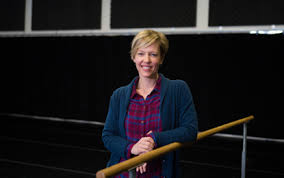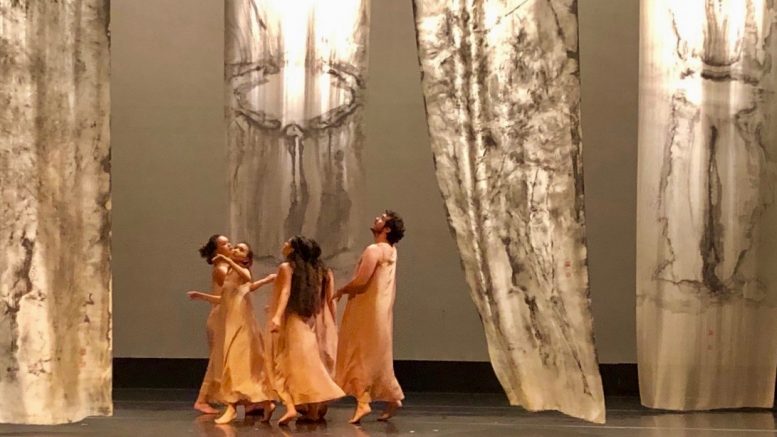By Patti Roberts
Dance is both a personal and a collective art – live performances a melding of the two.
On stage, dancers have a connection with one another and their audience, not to mention all the production elements that include music, costumes, set design and lighting.
“Interplay and collaboration are both core components of dance training and performance,” explained Sacramento State University Dance Professor Megan Brunsvold Mercedes. “Dancers will often contribute or modify movement ideas throughout the creative process.”
Mercedes, who teaches dance technique classes and workshops, added that dancers learn as much from being in class with other students as they do from their instructors.
“It’s a vulnerable and thrilling process,” she said. “Often a student will have an ‘a ha’ moment by watching or interacting with a classmate, seeing how they interpret the instruction or feedback given by the instructor.”
But all that changed when the classroom curtain suddenly fell two years ago after COVID-19 restricted in-person classes, leaving professors to scramble on how to keep their dance students active with online learning.
Through various platforms such as ZOOM, both instructors and students logged on during regular class time and dancing “together” in their respective spaces.
“It certainly involved a lot of trial and error regarding the technical challenges, because both instructors and students were often sharing both their space and internet connection with other members of their households,” said Mercedes, who was also juggling her in-home teaching while her two-year-old daughter who would occasionally drift in and out of camera range.
“One of the main elements of dance that students learn in a technique class is how to navigate and move through space,” she went on. “For many of us instructors, we shifted to dance strength and conditioning training, and practices that require less space for students to move through.”

The virtual classes were less than ideal, but there were huge advantages when instructors recognized the void and began sharing performance material online.
“Almost immediately there was a wonderful resource created via Facebook of dance educators from all over the country brainstorming and sharing ideas related to the virtual shift in teaching,” Mercedes recalled. “Topics covered many genres of dance and various types of classes and included trouble-shooting tech help such as the best audio settings for dance, or how to set up multiple cameras via ZOOM to give students multiple perspectives for viewing movement. The outpouring of ideas and generosity of spirit from the dance community was truly heartening.”
Though the procedures worked for some students, others opted out.
“It was extremely difficult to take dance classes online,” said Berenis Leonard, a senior with a double major of Dance and Kinesiology graduating this Spring. “I ended up not taking technique classes because it was too difficult, and I felt like I was missing out on the knowledge I could gain if I was in person. Music would lag, and movement wouldn’t align, and not having space at home made it more challenging.”
But Leonard made it clear that he recognizes the efforts the staff put in on keeping the classes active and did find one that worked for him.
“I did appreciate the class where we worked on compositions of choreography and applied it to social media platforms,” he noted. “The professors did their best, but it was a huge disadvantage for us students.”
When 2020 Fall semester rolled around, it was clear that the challenges were going to be long-term. And there was a need for performances despite the lockdowns.
This meant figuring out what to present, and how to present it.
“We ultimately created a virtual concert, UDC University Dance Company in December 2020,” explained Mercedes.
Students submitted audition videos and all rehearsals took place via ZOOM.
The concert showcased a variety of different ways to engage with filming and viewing dance on screen. Some dancers and choreographers were given permission for solo rehearsal inside the campus performance space, with faculty and staff helping with lighting and filming while remaining masked and socially distanced. In one instance, a choreographer created a duet using a split screen and sophisticated editing, though both dancers rehearsed and were filmed individually.
“It has been difficult, but part of our charge as creative artists is to continue to innovate and explore unknown possibilities,” Mercedes acknowledged. “As our world has slowly started to open up again, we’ve been able to incorporate more in-person classes, rehearsals, and performances. Though we continue to wear masks and have limited some of our interpersonal engagement.”
While Leonard did not participate in the online CSUS production, he did perform in University Dance Company and Sacramento Black Art of Dance 2020, as a professional belly dancer and as a hip hop teacher for Studio T Dance. His plans post-graduation is to become a physical therapist and open his own wellness studio focusing on dancers.


Be the first to comment on "Dancing in place: The ups and downs Sacramento’s next generation of dancers faced as California staggered through the pandemic "